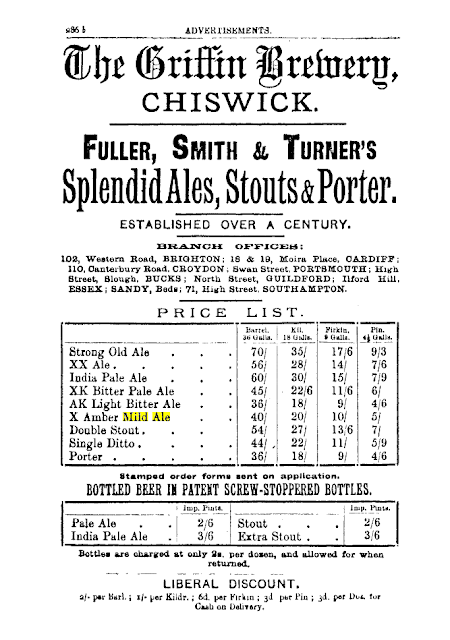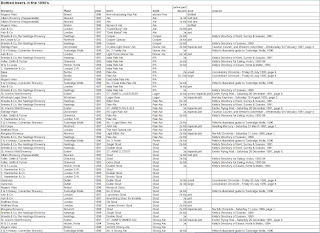We've arrived at the most thrilling part of the tale - where the beer finally gets put into bottles. And so quickly, too. It seems like only a month or two since we started savouring this text.
"Bottling the Beer
There are two units at present installed, but, as Mr. Pope said, if their bottled beer trade increases at the present rate considerable additions will have to be made. The bottling units each consist of a "Dawson" washer with a capacity of 400 dozen pints per hour, a 24-head "Pontifex" filler, an "Adriance" crowner, and an "Ermold" labeller. the "H.A." pasteuriser being fed from either.
At each point of vantage there is a "Benjamin reflector lamp focussing exactly on the spot most suitable for the operator. The absence of noise while both the units were in full swing was a very noticeable point. It was learnt that all the exhaust ports on the filler had been fitted with silencers and the crowner had also been softened down. The theory here was, less noise more output, and in practice it has completely proved itself.
If the beer is not to be pasteurised, four butterfly shaped sprayers are fitted over the bottle conveyor leading from the filler to the labeller, just washing off the external film of beer which might have been picked up in transit."
"A Modern West Country Brewery" by H.C. Vickery, 1934, pages 9 - 10.
I wonder why they gavce the capacity of the bottle washer but not the filler? Bit frustrating, that. One thing I have learned: Eldridge Pope used both crown corks and screw-tops to seal their bottles. Exciting or what? I've also learned that not all of their beer was pasteurised. I think I know which beer skipped pasteurisation, but we'll come to that in a later post. Best not get ahead of ourselves.
I'd never realised what a dangerous job being the stopper-tightener was:
"The operator simply pushes the top handle downwards, which tightens the screw stopper after it has been inserted by hand. One device has been incorporated by the company, and this is the leather guard just below the operator's right and left wrists. The stopper tightener was found to be a most dangerous "toy" without it, because if a bottle should split it entered the operator's wrist."
"A Modern West Country Brewery" by H.C. Vickery, 1934, page 12.
No-one - the morbidly suicidal excepted - wants their wrists slitting. You can see the leather guard in the illistration.
Now let's take a look at the pasteuriser:
"The Pasteuriser
This machine is on the upper floor, and one was glad to ascend from the arctic atmosphere in the cold room to the more genial temperature generated in this room. This pasteuriser is the product of a practical engineer, Mr. Austin, combined with the practical brewing and bottling experience of Mr. Hipwell, the head brewer of a Midland brewery. It is scientific in principle and simple in design. It uses practically no liquor and very little steam, and is driven by a 0.5 h.p. motor. The breakage claimed is under 0.2 per cent., and this figure was vouched for by Mr. Pope.
The system is simple; the beers are loaded and off-loaded from the slung baskets and these travel through warm water of about 75° F., passing along the bottom at a gradually ascending slope at 105º F. This slope is heated by lower steam coils, so that the bottles pass through a succession of rising temperatures until the culminating temperature is reached of about 140º F. These temperatures never vary, being thermostatically controlled. The bottles travel about 8 in. per minute.
A noteworthy feature of this machine is the silent way in which it works; nothing could be heard except the whirr of the motor. The top of the tank was lagged with bolsters, tightly packed with wood shavings, and the remarkable efficiency of this lagging was clearly demonstrated by the heat felt on one side of the bolster and the ordinary air temperature on the other."
"A Modern West Country Brewery" by H.C. Vickery, 1934, page 12.
140º F. seems a bit of a low temperature. There are bacteria - and even yeast - that can survive that level of heat. Look at those kids unloading the pasteuriser - how old are they? Some don't look more than 10.
This next bit had me scratching my head. I know breweries often had more than one bottling store, for the pretty obvious reason that beer was much cheaper to move around in bulk than in bottles. But I thought that, despite being one of the larger breweries in the West Country, Eldridge Pope were very regional. (Their regionality was one reason the artist thought he could get awaty with selling the same hunstman logo to them and Tetley.) Obviously not quite as regional as I thought.
"The Bulk Delivery Tank
The last illustration shows one of the aluminium bulk delivery tanks. This has a capacity of 25 barrels and weighs 6 tons when full. The tank has two compartments — one of 10 barrels and the other 15 barrels. This tank is filled from a main in the wall of the store and is used for delivery of the beer to another bottling store in Southampton. It is lifted on to the lorry by the crane which can be seen overhead, and although it carries 9 in. of cork lagging on the sides and 6 in. on the base, great care is taken that the beer shall arrive in perfect condition, for it travels in the cool of the day, leaving at 6.30 a.m. on its journey of only 50 miles."
"A Modern West Country Brewery" by H.C. Vickery, 1934, pages 10 and 12.
I guess Eldridge Pope must have done some business in the Southampton area.
We're very nearly done. Just one more post and then we can all brethe freely again.
* I do genuinely always write sitting down. I experimented doing it standing up once. Not for me, I quickly realised. I like my arse comfortably parked before getting all literary.































































































